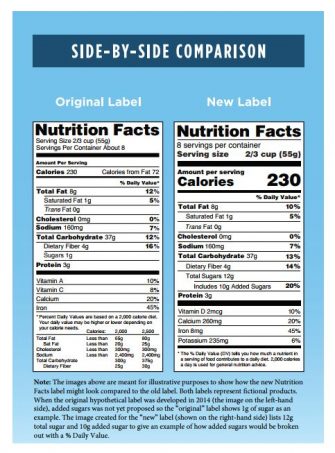Nutritional Facts Labels Are Getting A Make-over

When “Nutritional Facts” labels were first introduced more than 20 years ago they gave consumers access to vital data quickly and easily. To this day, in spite of knowing much more about diet and disease, the labels have remained basically unchanged. In May 2016, the FDA finalized a new, updated version of the labels. They have adjusted the labels to better represent the scientific knowledge currently available, update dietary recommendations and make them easier to read.
Companies have been given until 2020 to update labels on their products, with an extension for smaller companies until 2021. However, some companies have already made the switch and as we get closer to the deadline, the new labels will be seen more and more regularly. Here is an overview of what to look for on the new labels and how to effectively use them to make dietary decisions.
UPDATED LOOK
The overall look of the label will be very familiar, so it will still be easy to find. Within the label, changes to the type font size and style will help highlight key facts more easily. A few things to look for: “calories”, “servings per container” and “serving size” will be larger. Also, total calories and serving size data will be in bold font. Previously, the percentage of Daily Value had to be displayed for vitamin D, calcium, iron and potassium. With the new labels, in addition to the percentage, the actual amount will also have to be listed. There will also be a new footnote explaining the Daily Value. The meaning is not being changed, but the new explanation may help more people understand it.
UPDATED NUTRITION
The new label will highlight information that reflects updated research findings in the area of nutrition. Nutritionists now know that most people will struggle to get all their nutrients in their diet, and still stay in daily calorie limits, if they are consuming too much sugar (specifically, more than 10% of their daily calorie intake). Therefore, “Added Sugars” is a new feature to the label.
The list of nutrients is also being updated. Vitamin D and Potassium are being added as required nutrients. Calcium and Iron will continue to be required. Vitamin A & C are no longer required, but may be included voluntarily. Additionally, Daily Values for some nutrients such as sodium, vitamin D and dietary fiber are being updated to reflect recent scientific evidence.
Because research has shown that the type of fat is more important than the amount of fat, “Total Fat”, Saturated Fat, and “Trans Fat” will continue to be required. “Calories from Fat” is no longer required.
UPDATED SERVING INFORMATION
Over the years, the serving sizes in the US have changed. While the serving size was updated in 1993, that data is no longer the norm and has been updated again. For example: the serving size for soda is changing from 8oz to 12oz. Meanwhile the serving size for yogurt has been reduced from 8 oz to 6 oz.
The law states that serving sizes should be based on the amount that people actually eat rather than what they should be eating. Regardless of stated serving size, people often eat what is in a package. Therefore, when foods are packaged with an amount that is between 1 and 2 servings, (e.g. a 20 oz soda) the label will be required to reflect the whole package as a single serving.
Some foods are packaged in a way that could easily be divided into multiple servings OR consumed as a single serving. In these cases, manufacturers will be required to provide a “dual column” label. This will make it easy to see the difference between “per serving” data and the “per package/unit” data.
BENEFITS OF THE NEW LABEL
Together, the changes will provide a more concise listing of vital information on the foods we eat. By learning to count your calories and nutrients based on the actual serving size you consume, you will get a better look at your actual dietary intake.
It is important to have a healthy diet that derives nutrients from a variety of sources. Watch the labels on your food products and pay attention to the data they are giving you. Then you can decide if this item fits within your eating plan as frequent, occasional, rare special treat, or not all at all. Know what your body needs, then feed it well.
You can also find more articles and research information on nutrition and many other topics at https://www.tnchiro.com/articles/ and https://www.tnchiro.com/research/ . Your doctor of chiropractic has training in proper nutrition and can help you balance your food plan for a healthier life. Ask about healthy eating at your next appointment!
Additional information about the new food labels can be found at https://www.fda.gov/Food/GuidanceRegulation/GuidanceDocumentsRegulatoryInformation/LabelingNutrition/ucm385663.htm#highlights